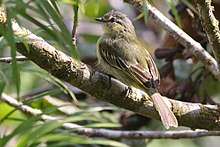| Peruvian tyrannulet | |
|---|---|

| |
| Scientific classification | |
| Domain: | Eukaryota |
| Kingdom: | Animalia |
| Phylum: | Chordata |
| Class: | Aves |
| Order: | Passeriformes |
| Family: | Tyrannidae |
| Genus: | Zimmerius |
| Species: | Z. viridiflavus |
| Binomial name | |
| Zimmerius viridiflavus (Tschudi, 1844) | |

| |
| Range of Peruvian tyrannulet (south) and Loja tyrannulet (north). (See the taxonomy section.) | |
The Peruvian tyrannulet (Zimmerius viridiflavus) is a species of bird in the family Tyrannidae, the tyrant flycatchers. It is endemic to Peru.
Taxonomy and systematics
The Peruvian tyrannulet was originally described as Elaenia viridiflava. It was later reclassified as a subspecies of the golden-faced tyrannulet (then Tyrannulus chrysops, now Zimmerius chrysops). Through much of the twentieth century the golden-faced tyrannulet and several other tyrannulets were kept in genus Tyranniscus but a study published in 1977 erected the present genus Zimmerius for them.
Beyond its transfer to Zimmerius as a subspecies of the golden-faced tyrannulet, the Peruvian tyrannulet's taxonomy is unsettled. The International Ornithological Committee (IOC) follows a study published in 2008 and splits it from the golden-faced tyrannulet as a monotypic species. The South American Classification Committee of the American Ornithological Society, the Clements taxonomy, and BirdLife International's Handbook of the Birds of the World (HBW) also treat Z. viridiflavus as a species. However, they include in it a second subspecies which the IOC treats as a separate species, the Loja tyrannulet (Z. flavidifrons).
This article follows the monotypic species IOC model.
Description
The Peruvian tyrannulet is about 11 to 12 cm (4.3 to 4.7 in) long and weighs 9 to 10 g (0.32 to 0.35 oz). The sexes have the same plumage. Adults have pale yellow lores and eye-ring and a dark stripe through the eye on an otherwise buff-washed bright olive face. Their crown is darkish olive to grayish olive and their back and rump are bright olive. Their wings are dark dusky with bright yellow-green edges on the coverts and flight feathers. Their tail is dusky olive. Their throat is pale yellow, their breast and flanks olive-yellow with some olive markings, and their belly bright yellow. They have a gray to medium brown iris with a tan rim, a small, rounded, bill whose maxilla is gray to blackish and mandible medium gray, and dark gray to black legs and feet.
Distribution and habitat
The Peruvian tyrannulet is found intermittently on the east side of the central Peruvian Andes in the departments of Huánuco, Junín, and Ayacucho. It primarily inhabits the canopy and edges of humid montane forest and occasionally occurs in secondary forest. In elevation it ranges between 1,000 and 2,500 m (3,300 and 8,200 ft).
Behavior
Movement
The Peruvian tyrannulet is a year-round resident throughout its range.
Feeding
The Peruvian tyrannulet feeds on insects; it probably also feeds on small fruits like those of mistletoes (Loranthaceae). It forages singly or in pairs and often joins mixed-species feeding flocks. It feeds mostly in the forest canopy, perching horizontally with its tail cocked and actively moving about and gleaning food while perched or with short flights.
Breeding
Nothing is known about the Peruvian tyrannulet's breeding biology.
|
Songs and calls Listen to the Peruvian tyrannulet on xeno-canto |
Vocalization
The Peruvian tyrannulet's dawn song is "a rising, musical, chiming series tew-tew-tee" and its call "a 1-4 note upslurred hooooeet? or huhu-hu eeet?".
Status
The IUCN follows HBW taxonomy so its assessment of the Peruvian tyrannulet includes the Loja tyrannulet. The Peruvian tyrannulet occurs in at least one protected area in Huánuco.
References
- ^ Gill, Frank; Donsker, David; Rasmussen, Pamela, eds. (August 2024). "Tyrant flycatchers". IOC World Bird List. v 14.2. Retrieved 19 August 2024.
- Tschudi, Johann Jakob von (1844). "Avium conspectus". Archiv für Naturgeschichte (in Latin). 10 (1). Nicolai: 274.
- ^ Remsen, J. V., Jr., J. I. Areta, E. Bonaccorso, S. Claramunt, G. Del-Rio, A. Jaramillo, D. F. Lane, M. B. Robbins, F. G. Stiles, and K. J. Zimmer. Version 28 September 2024. A classification of the bird species of South America. American Ornithological Society. https://www.museum.lsu.edu/~Remsen/SACCBaseline.htm retrieved September 29, 2024
- Traylor, M. A. (1977). A classification of the tyrant flycatchers (Tyrannidae). Bulletin of the Museum of Comparative Zoology 148:128–184.
- Rheindt, F.E.; Norman, J.A.; Christidis, L. (2008). "DNA evidence shows vocalizations to be better indicator of taxonomic limits than plumage patterns in Zimmerius tyrant-flycatchers". Molecular Evolution and Phylogenetics. 48 (1): 150–156.
- Clements, J. F., P.C. Rasmussen, T. S. Schulenberg, M. J. Iliff, T. A. Fredericks, J. A. Gerbracht, D. Lepage, A. Spencer, S. M. Billerman, B. L. Sullivan, M. Smith, and C. L. Wood. 2024. The eBird/Clements checklist of birds of the world: v2024. Downloaded from https://www.birds.cornell.edu/clementschecklist/download/ retrieved October 23, 2024
- HBW and BirdLife International (2024). Handbook of the Birds of the World and BirdLife International digital checklist of the birds of the world. Version 8.1. Available at: https://datazone.birdlife.org/species/taxonomy retrieved August 26, 2024
- ^ Fitzpatrick, J. W. and D. A. Christie (2020). Peruvian Tyrannulet (Zimmerius viridiflavus), version 1.0. In Birds of the World (J. del Hoyo, A. Elliott, J. Sargatal, D. A. Christie, and E. de Juana, Editors). Cornell Lab of Ornithology, Ithaca, NY, USA. https://doi.org/10.2173/bow.pertyr1.01 retrieved November 13, 2024
- ^ Schulenberg, T.S.; Stotz, D.F.; Lane, D.F.; O'Neill, J.P.; Parker, T.A. III (2010). Birds of Peru. Princeton Field Guides (revised and updated ed.). Princeton, NJ: Princeton University Press. p. 406. ISBN 978-0691130231.
- BirdLife International (2024). "Peruvian Tyrannulet Zimmerius viridiflavus". IUCN Red List of Threatened Species. 2024: e.T22699156A264357859. Retrieved 13 November 2024.
| Taxon identifiers | |
|---|---|
| Zimmerius viridiflavus | |
